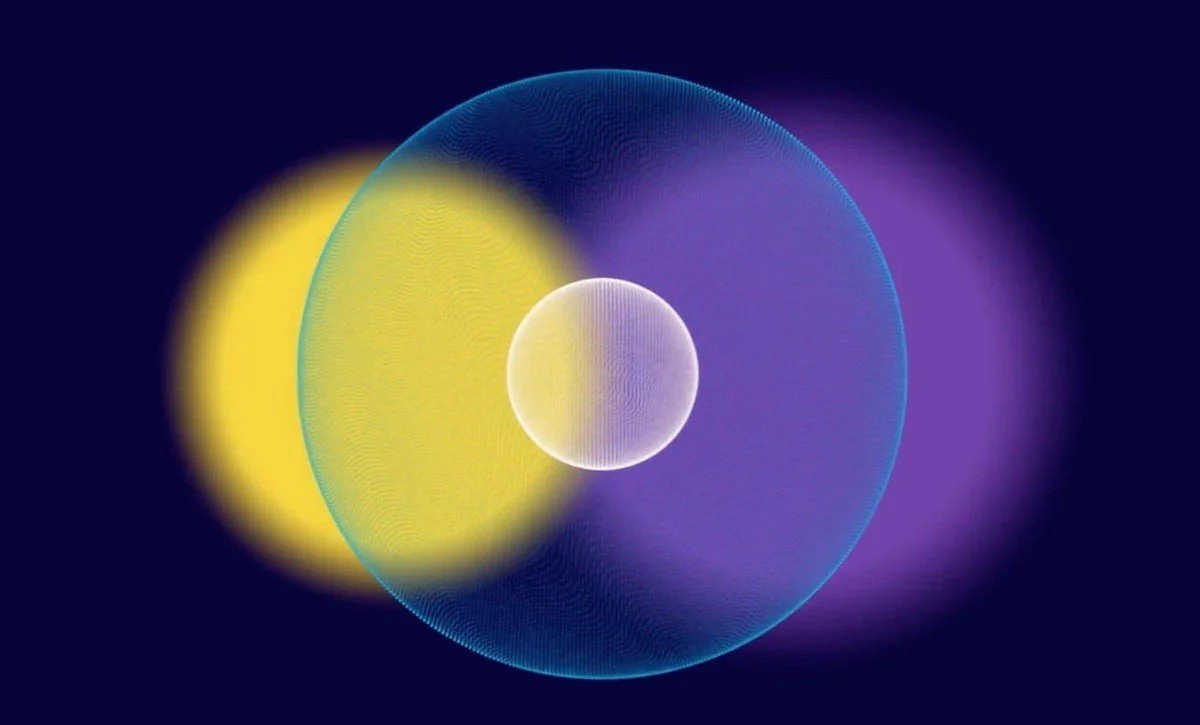The synergy between music and psychedelics
Image Source: Wavepaths via The Evening Standard
The “setting” of a therapeutic session, meaning the environment, tremendously influences the experience, and music is part of the setting. The text below summarises the first steps in my research on the role of music in designing psychedelic experiences for therapy and the associated impact on human cognitive functioning.
By Alexandra Plesner
Music has been historically important to humans as a tool to guide or support experiences during the administration of psychedelics (Barrett et al., 2018; Eisner & Cohen, 1958) and to give meaning, express feelings, and potentially support soulful emotionality. At present, music selection for psychedelic therapy is not standardized. Some music features may support the mystical experience and guide the patient’s journey (Barrett et al., 2017).
The connection: music and altered states of consciousness
The induction and expression of emotions through music have been used in shamanistic practice and various cultures for ages. Music is ancient, with the oldest known musical instruments appearing in the archaeological record from 40,000 years ago (Killin, 2018, p. 1).
New research on music has begun to address its capacity to support altered states, such as transcendental experiences (Hove et al., 2016), its ability to convey and modulate emotion (Kaelen et al., 2015), and the induction of flowing states of ecstasy and hallucination (Jourdain, 2008). Like music, archaeology indicates the ancient global use of psychedelics, already attested during the Neolithic (around 11000 BC) periods (Samorini, 2019).
Music is a vital element of the setting that can influence drug experiences significantly (Kaelen, 2018) and support the therapeutic experience and meaning-making (Eisner, 1997; Eisner & Cohen, 1958; Kaelen et al., 2015; Kaelen et al., 2018). Music directly influences the emotional experience within a setting and should be selected carefully, responsibly, and attuned for a patient as an individual (Bonny & Pahnke, 1972; Kaelen et al., 2015).
Music as part of the setting
The music experience during psychedelic therapy provides a sense of safety and calm and correlates with mystical experiences and insightfulness. Music seems to be a supportive guide during the onset, ascent, and return phases of the psychedelic experience (Kaelen et al., 2018; Pollan, 2018).
The quality of the music experience has been associated with therapy outcomes and, more specifically, a music experience characterized by personal ‘resonance’ (Kaelen et al., 2018). Therefore, the music selection requires careful and intelligent optimization, potentially even tailored to the individual patient.
To quote Gabrielsson (2011): “When music takes over, the surrounding world disappears. Time stands still; all that counts is the music and me, here and now. Sometimes, the circumstances around the experience seem to be particularly favourable for the person to merge with the music. In some way, the music acquires a special clarity, and one is totally indeed the music” (p.77).
Your brain on music
Brains are parallel processors running with a perceptual system, and our perceptual system allows us to fill in the missing information gaps through experience to help make decisions quickly (Levitin, 2006). Our ability to make sense of music depends on experience and neural structures that can learn and modify themselves with each new song we hear and with each new listening to an old song. Our brains learn a kind of musical grammar specific to our culture’s music, just as we learn to speak the language of our culture (Levitin, 2006).
Your brain on psychedelics
Psychedelics produce an altered state of consciousness characterized by marked reductions in functional coupling within high-level brain networks. At the same time, they increase connection in other low-level areas of the brain (Pollan, 2018; Kaelen et al., 2015).
Psychedelic drugs affect our ability to receive and interpret auditory information, such as music, and how we emotionally react to it (Barrett et al., 2018; Kaelen et al., 2015; Hoffer, 1965). A study with psilocybin, for example, illustrates that psilocybin disrupts the typical organization of the brain, leads to a less constrained and more intercommunicating mode, and new connections between areas of the brain that are not present in a normal state (Petri et al., 2014).
A study with psilocybin, for example, illustrates that psilocybin disrupts the typical organization of the brain, leads to a less constrained and more intercommunicating mode, and new connections between areas of the brain that are not present in a normal state (Petri et al., 2014).
Brain regions recruited during music listening overlap at least partially with brain regions where activity and connectivity are altered after the administration of psychedelics” (Barrett et al., 2018, pg. 3).
The synergy between music and psychedelics
Classical psychedelics are serotonin 2A receptor agonists, which activate that receptor in the brain. Serotonergic neurons in the brain respond specifically to auditory stimuli, allowing increased synergy between music and psychedelics (Hurley & Pollak, 1999).
Barrett et al. (2017) suggest that psychedelics allow for the fuller processing of music and its emotional features by diminishing the usual regulatory processes of music-evoked emotion.
In an interview, Jon Hopkins summed it up perfectly: “The psychedelic space needs a lot of new music that is designed for it. Otherwise, you have a playlist made of a hundred different energies. It’s like someone new coming into the room every 10 minutes and bringing their stuff into your space.” (Carreon, 2021).
Personal deep listening experience via Wavepaths
I experienced Wavepaths through an immersive deep listening session with Dr. Mendel Kaelen end of 2021. Wavepaths is a music company that collaborates with musicians to provide curated music for psychedelic therapy. The program builds sound environments through adaptive AI music-generation technology based on different factors, including emotions and the type of medicine a person consumes (Siebert, 2021, para. 3).
The event began with a 30-minute introduction to Wavepaths. It was followed by a deep listening session, where we were encouraged to focus on nothing but the music, accept the entirety of the experience without judgment, and surrender to the unfolding journey. After the introduction, we received a link to the actual musical experience (without video). We were asked to get comfortable, use our best headphones or speakers, get eyeshades, and reflect before starting.
The sound characteristics felt like predictable instrumentation: soft, not stimulating, warm, and deep initially. As the music’s dynamics picked up the pace, the strident sound of bells burst my bubble of comfort. It was annoying; the sound patterns exploded, and every tiny piece felt like multiplying in infinity. At times I did not want the experience to end, and at other moments, I felt the urge to end it and exit. The journey was extraordinary and a breakthrough regarding facing some feelings. It was not fundamentally different from other experiences I had with sound since I have always had a special relationship with music. Still, my first time consciously trying sound for a therapeutic reason.
It is worth mentioning that I did not take any psychedelics during the Wavepaths experience. I was grateful for the opportunity to be able to test their system.
In conclusion
In conclusion, combining psychedelics and music can increase openness, mental imagery, and emotions. It is worth studying how specific music patterns give rise to particular neural activations in the brain and how this interaction varies depending on the type of psychedelics used, the dosage, and the setting. How exactly do music and psychedelics affect neural networks and expand human cognition? How can synergetic use improve psychedelic therapy?
I believe creating music for psychedelic states requires an architectural approach with various interconnected dimensions that a journeyer can explore. The playlist should be bespoke, responsive, consistent, and the environment cohesive. Music, however, is a guide to the journey and is very influential. This opens the question of timing. When is music helpful, and when would it be more beneficial to allow the patient to journey without the direct influence of a human guide and music?
Learn more about the importance of set and setting, especially in context with psilocybin-containing mushrooms, via our self-paced online course.
-
Barrett, F. S., Preller, K. H., & Kaelen, M. (2018). Psychedelics and music: Neuroscience and therapeutic implications. International Review of Psychiatry, 30(4), 350–362. https://doi.org/10.1080/09540261.2018.1484342
Barrett, F. S., Robbins, H., Smooke, D., Brown, J. L., & Griffiths, R. R. (2017). Qualitative and quantitative features of music reported to support peak mystical experiences during psychedelic therapy sessions. Frontiers in Psychology, 8. https://doi.org/10.3389/fpsyg.2017.01238
Bonny, H. L., & Pahnke, W. N. (1972). The use of music in psychedelic (LSD) psychotherapy. Journal of Music Therapy, 9(2), 64–87. https://doi.org/10.1093/jmt/9.2.64
Carreon, M. (2021, December 2). The Psychedelic Renaissance is ushering in a new genre of electronic music — and with it, new revenue streams. Billboard. https://www.billboard.com/music/music-news/psychedelic-therapy-music-jon-hopkins-superposition-east-forest-mdma-psilocybin-lsd-1235003741/
Eisner, B. (1997). Set, setting, and Matrix. Journal of Psychoactive Drugs, 29(2), 213–216. https://doi.org/10.1080/02791072.1997.10400190
Eisner, B. G. & Cohen, S. (1958). Psychotherapy with lysergic acid diethylamide. The Journal of Nervous and Mental Disease, 127(6), 528–539. https://doi.org/10.1097/00005053-195812000-00006
Gabrielsson, A. (2011). Strong experiences with music: Music is much more than just music. OUP Oxford.
Hoffer, A. (1965). D-lysergic acid diethylamide (LSD): A review of its present status. Clinical Pharmacology & Therapeutics, 6(2), 183–255. https://doi.org/10.1002/cpt196562183
Hove, M. J., Stelzer, J., Nierhaus, T., Thiel, S. D., Gundlach, C., Margulies, D. S., Van Dijk, K. R., Turner, R., Keller, P. E., & Merker, B. (2016). Brain Network reconfiguration and Perceptual Decoupling during an absorptive state of consciousness. Cerebral Cortex, 26(7), 3116–3124. https://doi.org/10.1093/cercor/bhv137
Hurley, L. M., & Pollak, G. D. (1999). Serotonin differentially modulates responses to tones and frequency-modulated sweeps in the inferior colliculus. The Journal of Neuroscience, 19(18), 8071–8082. https://doi.org/10.1523/jneurosci.19-18-08071.1999
Jourdain, R. (2008). Music, the brain, and ecstasy: How music captures our imagination. William Morrow.
Levitin, D. J. (2006). This is your brain on music. Penguin Group.
Kaelen, M., Barrett, F. S., Roseman, L., Lorenz, R., Family, N., Bolstridge, M., Curran, H. V., Feilding, A., Nutt, D. J., & Carhart-Harris, R. L. (2015). LSD enhances the emotional response to music. Psychopharmacology, 232(19), 3607–3614. https://doi.org/10.1007/s00213-015-4014-y
Kaelen, M., Giribaldi, B., Raine, J., Evans, L., Timmerman, C., Rodriguez, N., Roseman, L., Feilding, A., Nutt, D., & Carhart-Harris, R. (2018). The hidden therapist: Evidence for a central role of music in psychedelic therapy. Psychopharmacology, 235(2), 505–519. https://doi.org/10.1007/s00213-017-4820-5
Killin, A. (2018). The origins of music: Evidence, theory, and prospects. Music & Science. https://doi.org/10.1177/2059204317751971
Pollan, M. (2018). How to change your mind: What the new science of psychedelics teaches us about consciousness, dying, addiction, depression, and transcendence. Penguin Random House.
Samorini, G. (2019). The oldest archeological data evidencing the relationship of homo sapiens with psychoactive plants: A worldwide overview. Journal of Psychedelic Studies, 3(2), 63–80. https://doi.org/10.1556/2054.2019.008
Siebert, A. (2021, October 28). Wavepaths: The neuroscientist-founded company producing music for-and as-psychedelic therapy. Forbes. https://www.forbes.com/sites/amandasiebert/2021/10/28/wavepaths-the-neuroscientist-founded-company-producing-music-for-and-as-psychedelic-therapy/?sh=1162fa101788


